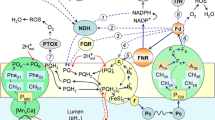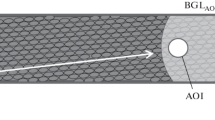Abstract
Characteristic steady-state mRNA level oscillations were monitored for the chlorophyll a/b-binding (cab) protein in tomato plants grown under the natural day/night (light/dark) regime as well as under constant environmental conditions. This typical expression pattern was altered when plants were transferred to different light/dark regimes. For example, by shifting the light phase by six hours, a change of the time points of maximum and minimum of expression level was monitored, while the principal oscillation pattern remained the same. It appeared that the transition from dark to light is involved in determining the time points of minima and maxima of mRNA accumulation.
After exposing tomato plants to an abnormal light/dark periodicity (e.g. six hours of alternating light/dark) an altered oscillation pattern was determined: within 24 hours two maxima of cab mRNA levels were detected. However, this ‘entrained’ abnormal rhythm was not manifested at the molecular level and the circadian pattern reappeared under constant environmental conditions (e.g. darkness). This result favours the hypothesis that the oscillation pattern of the cab mRNA in tomato plants is not only endogenous but also hereditary.
Similar content being viewed by others
References
Britz SJ, Hungerford WE, Lee DR: Rhythms during extended dark periods determine rates of net photosynthesis and accumulation of starch and soluble sugars in subsequent light periods in leaves of Sorghum. Planta 171: 339–345 (1987).
Bünning E: Insight into the hereditary diurnal periodicity of the primordial leaves of Phaseolus multiflorus. Jahrb Wiss Bot 81: 411–418 (1935).
Bünning E: Endogenous daily rhythms as the basis of photoperiodism. Ber Deut Bot Ges 54: 590–607 (1936).
Bünning E. Endogenous rhythms in plants. Ann Rev Plant Physiol 7: 71–90 (1956).
Bünsow R: Endogene Tagesrhythmik und Photoperiodismus bei Kalanchoe blossfeldiana. Planta 42: 220–252 (1953).
Feldman JF: Genetic approaches to circadian clocks. Ann Rev Plant Physiol 33: 583–608 (1982).
Griffiths WT, Kay AS, Oliver RP: The presence of photoregulation of protochlorophyllide reductase in green tissue. Plant Mol Biol 4: 13–22 (1985).
Hasegawa K, Tanakadate A: The Paramecium circadian clock. Naturwissenschaften 75: 263–265 (1988).
Jerebzoff S: Cellular circadian rhythms in plants: recent approaches to their molecular bases. Physiol Veg 24: 367–376 (1986).
Kleinhoonte A: Untersuchungen über die autonomen Bewegungen der Primärblätter von Canavalia ensiformis. Jahrb Wiss Bot 75: 679–724 (1932).
Kloppstech K: Diurnal and circadian rhythmicity in the expression of light-induced plant nuclear messenger RNAs. Planta 165: 502–506 (1985).
Kuhlemeier C, Green PJ, Chua NH: Regulation of gene expression in higher plants. Genes Dev 1: 247–255 (1987).
Maniatis T, Fritsch EF, Sambrook J: Molecular Cloning: A Laboratory Manual. Cold Spring Harbor Laboratory Press, Cold Spring Harbor, NY (1983).
Meyer H, Thienel U, Piechulla B: Molecular characterization of the diurnal/circadian expression of the chl a/b binding proteins in leaves of tomato and other dicotyledonous and monocotyledonous plant species. Planta (manuscript submitted).
Nagy F, Kay SA, Chua N-H: A circadian clock regulates transcription of the wheat cab-1 gene. Genes Dev 2: 376–382 (1988).
Piechulla B, Pichersky E, Cashmore AR, Gruissem W: Expression of nuclear and plastid genes for photosynthesis-specific proteins during tomato fruit development and ripening. Plant Mol Biol 7: 367–376 (1986).
Piechulla B, Gruissem W. Diurnal mRNA fluctuations of nucelar and plastid genes in developing tomato fruits. EMBO J 6: 3595–3599 (1987).
Piechulla B: Plastid and nuclear mRNA fluctuations in tomato leaves-diurnal and circadian rhythms during extended dark and light periods. Plant Mol Biol 11: 345–353 (1988).
Pittendrigh CS: The circadian oscillation in Drosophila pseudoobscura pupae: A model for the photoperiodic clock. Z Pflanzenphysiol 54: 275–307 (1966).
Roenneberg T, Hastings JW: Two photoreceptors control the circadian clock of a unicellular alga. Naturwissenschaften 75: 206–207 (1988).
Sargent ML, Briggs WR, Woodward DO: The circadian nature of a rhythm expressed by an invertase-less strain of Neurospora crassa. Plant Physiol 41: 1343–1349 (1966).
Satter RL, Galston AW: Mechanisms of control of leaf movements. Ann Rev Plant Physiol 32: 83–110 (1981).
Schmidle A: Die Tagesperiodizität der asexuellen Reproduktion von Pilobulus sphaerosporus Arch Microbiol 16: 80–100 (1951).
Spiller SC, Kaufman LS, Thompson WF, Bruggs WR: Specific mRNA and rRNA levels in greening pea leaves during recovery form iron-stress. Plant Physiol 84: 409–411 (1987).
Schweiger HG: Cell biology of Acetabularia. Curr Top Microbiol Immunol 50: 1–36 (1969)
Stayton M, Brosio P, Dunsmuir P: Photosynthetic genes of Petunia (Mitchell) are differentially expressed during the diurnal cycle. Plant Physiol (in press).
Taylor WC: Transcriptional regulation by a circadian rhythm. Plant Cell (in press).
Tobin E, Silverthorne J: Light regulation of gene expression in higher plants. Ann Rev Plant Physiol 36: 569–593 (1985).
Uebelmesser ER: Über den endonomen Tagesrhythmus der Sporangienträgerbildung von Pilobulus. Arch Microbiol 20: 1–33 (1954).
Vince-Prue D: Photomorphogenesis and flowering. In: Shropshire W, Mohr H (eds) Encyclopedia of Plant Physiology, vol. 16B, pp. 458–490. Springer Verlag, Berlin (1983).
Author information
Authors and Affiliations
Rights and permissions
About this article
Cite this article
Piechulla, B. Changes of the diurnal and circadian (endogenous) mRNA oscillations of the chlorophyll a/b binding protein in tomato leaves during altered day/night (light/dark) regimes. Plant Mol Biol 12, 317–327 (1989). https://doi.org/10.1007/BF00043209
Received:
Accepted:
Issue Date:
DOI: https://doi.org/10.1007/BF00043209




